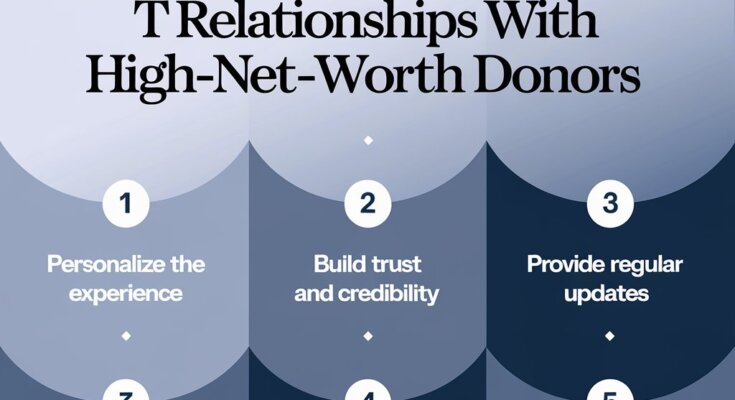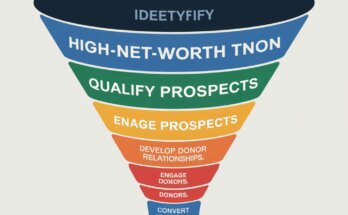To build lasting relationships with high-net-worth donors is crucial for nonprofits seeking long-term success and sustainability.
These individuals possess the resources and influence to significantly impact your organization, but cultivating these connections requires intentional effort and strategic planning.
In this post, we’ll explore five proven strategies that can help your nonprofit create meaningful relationships with high-net-worth donors, ensuring they remain engaged and supportive for years to come.
1. Understand Their Values and Interests
The first step in building a lasting relationship with high-net-worth donors is to understand their values and interests. Donors are more likely to support causes that resonate with their personal beliefs and experiences.
To achieve this, conduct thorough research on potential donors. Utilize tools like social media, news articles, and personal connections to gather information about their philanthropic goals and areas of interest.
Practical Example:
Imagine your nonprofit focuses on environmental conservation.
Before approaching a high-net-worth individual, you discover that they are passionate about wildlife protection, particularly elephants.
By tailoring your messaging to highlight your organization’s work in wildlife conservation and how their support could make a direct impact, you demonstrate your understanding of their values, making them more likely to engage with your cause.
Consider the story of a small nonprofit, “Wildlife Guardians,” that struggled to secure funding. After conducting extensive research on potential high-net-worth donors, they discovered that one of their prospects, a successful entrepreneur, had a lifelong passion for protecting endangered species.
Instead of a generic pitch, Wildlife Guardians organized a personalized presentation showcasing their recent efforts in elephant conservation. They included compelling visuals and success stories from the field.
This targeted approach not only captured the donor’s interest but also led to a significant contribution that helped fund critical conservation projects.
2. Build Genuine Connections
Once you understand a donor’s values and interests, it’s time to build a genuine connection. High-net-worth individuals appreciate authenticity and personal interactions over transactional relationships.
Engage with them through personalized communication, whether via email, phone calls, or in-person meetings. Show genuine interest in their lives, listen to their stories, and ask thoughtful questions.
Practical Example:
When sending a thank-you note to a donor after receiving a gift, take the time to include a personalized message. Reference a recent conversation you had with them or an event they attended.
For instance, you might say, “I loved hearing about your trip to Africa! It was inspiring to learn how your experiences shape your passion for wildlife conservation.” This personal touch helps reinforce your relationship and makes the donor feel valued beyond their financial contribution.
3. Keep Them Informed and Engaged
High-net-worth donors want to see the impact of their contributions and stay informed about your nonprofit’s activities. Regularly provide updates on your organization’s progress, share success stories, and highlight upcoming projects. Create engaging content, such as newsletters, social media posts, and videos, to keep them connected to your mission.
Practical Example:
Consider sending quarterly impact reports that summarize how donor funds are being utilized. Include compelling stories, statistics, and visuals that showcase the positive changes their contributions have made.
For instance, if a donor funded a new community education program, share testimonials from participants and photographs of the program in action. This keeps donors engaged and reinforces their belief in your organization’s work.
A nonprofit called “Education for All” implemented a unique strategy to keep their high-net-worth donors informed. They developed a series of short videos featuring beneficiaries of their educational programs sharing their stories.
These videos were shared in newsletters and on social media, providing a personal touch that resonated with donors. One donor, moved by the video of a young girl who received a scholarship, decided to increase their annual contribution significantly. By creating emotional connections through storytelling, Education for All cultivated a stronger relationship with their supporters.
4. Recognize and Appreciate Their Contributions
Recognition is a powerful tool to build lasting relationships with high-net-worth donors. High-net-worth individuals often expect acknowledgment for their generosity. Take the time to recognize their contributions publicly and privately.
This can be done through naming opportunities, donor appreciation events, and social media shout-outs. Make them feel special and appreciated for their support.
Practical Example:
Host an annual gala to recognize your high-net-worth donors and their contributions. During the event, highlight specific projects they funded and share success stories.
Consider giving awards or certificates of appreciation to acknowledge their generosity. Additionally, send personalized thank-you letters after the event to express your gratitude.
A nonprofit named “Health for Humanity” organized an annual appreciation gala where they honored their top donors. The event featured inspiring testimonials from beneficiaries and highlighted the direct impact of donor contributions.
One particular donor, who had provided substantial funding for a health clinic, was publicly recognized during the event. The emotional experience made the donor feel valued and appreciated, leading them to pledge additional funding for future projects.
5. Foster Ongoing Relationships
Building lasting relationships with high-net-worth donors is not a one-time effort; it requires ongoing engagement. Continuously nurture these relationships by inviting them to events, sharing updates, and including them in special initiatives. By involving them in your organization’s journey, you create a sense of ownership and loyalty.
Practical Example:
Consider creating a donor advisory board that includes high-net-worth individuals who have a vested interest in your mission. This allows them to provide input on strategic decisions and feel more connected to your organization. Additionally, invite them to exclusive behind-the-scenes tours or meetings to see firsthand the work being done.
A nonprofit called “Arts for All” established a donor advisory board comprised of high-net-worth individuals passionate about the arts. The board met quarterly to discuss future projects and initiatives.
During these meetings, donors had the opportunity to share their insights and contribute to the organization’s direction. This collaborative approach fostered a sense of ownership among the donors, leading to increased financial support and advocacy for the organization in their networks.
Conclusion
It is essential to Build lasting relationships with high-net-worth donors for the long-term success of your nonprofit.
To continue learning more about effective donor engagement strategies, subscribe to the Nonprofit Navigators Newsletter for expert tips and resources. And don’t forget to download, Top 10 Donor Stewardship Strategies for Nonprofits + Free Donor Engagement Checklist to help you implement these strategies effectively.
Building relationships with high-net-worth donors is an ongoing journey. Start today, and watch your nonprofit thrive!




